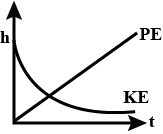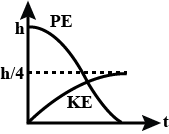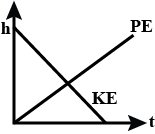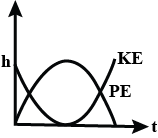
Answer
461.1k+ views
Hint: When a body falls freely under the influence of the gravitational force, its potential and kinetic energy changes during its motion but the sum of the potential energy and kinetic energy at every point remains constant.
Complete step by step answer:When a raindrop falls freely, then at a height $h$ above the ground its potential energy is maximum and kinetic energy is zero. During the fall, the potential energy of the raindrop keeps decreasing and kinetic energy goes on increasing up to a height $\dfrac{h}{4}$ above the ground. At this stage, rain drop has acquired terminal velocity. Thereafter its velocity remains constant. Therefore, at this stage, kinetic energy becomes constant. Potential energy becomes zero when a raindrop falls to the ground.
Hence, option (B) is correct.
Note:When a body falls freely through the atmosphere, two external forces will act on it. One of them is the gravitational force, expressed as the weight of the object. The other force is the air resistance, or drag of the object. An object dropped from rest such as a raindrop will increase its speed until it reaches terminal velocity. When terminal velocity of the object is achieved, then the speed of a moving object is no longer increased or decreased, that is the object’s acceleration becomes zero. At terminal velocity the air resistance equals in magnitude to the weight of the falling object. As the two forces are oppositely directed, the total force on the object is zero and the speed of the object becomes constant.
Complete step by step answer:When a raindrop falls freely, then at a height $h$ above the ground its potential energy is maximum and kinetic energy is zero. During the fall, the potential energy of the raindrop keeps decreasing and kinetic energy goes on increasing up to a height $\dfrac{h}{4}$ above the ground. At this stage, rain drop has acquired terminal velocity. Thereafter its velocity remains constant. Therefore, at this stage, kinetic energy becomes constant. Potential energy becomes zero when a raindrop falls to the ground.
Hence, option (B) is correct.
Note:When a body falls freely through the atmosphere, two external forces will act on it. One of them is the gravitational force, expressed as the weight of the object. The other force is the air resistance, or drag of the object. An object dropped from rest such as a raindrop will increase its speed until it reaches terminal velocity. When terminal velocity of the object is achieved, then the speed of a moving object is no longer increased or decreased, that is the object’s acceleration becomes zero. At terminal velocity the air resistance equals in magnitude to the weight of the falling object. As the two forces are oppositely directed, the total force on the object is zero and the speed of the object becomes constant.
Recently Updated Pages
Fill in the blanks with suitable prepositions Break class 10 english CBSE

Fill in the blanks with suitable articles Tribune is class 10 english CBSE

Rearrange the following words and phrases to form a class 10 english CBSE

Select the opposite of the given word Permit aGive class 10 english CBSE

Fill in the blank with the most appropriate option class 10 english CBSE

Some places have oneline notices Which option is a class 10 english CBSE

Trending doubts
Fill the blanks with the suitable prepositions 1 The class 9 english CBSE

How do you graph the function fx 4x class 9 maths CBSE

When was Karauli Praja Mandal established 11934 21936 class 10 social science CBSE

Which are the Top 10 Largest Countries of the World?

What is the definite integral of zero a constant b class 12 maths CBSE

Why is steel more elastic than rubber class 11 physics CBSE

Distinguish between the following Ferrous and nonferrous class 9 social science CBSE

The Equation xxx + 2 is Satisfied when x is Equal to Class 10 Maths

Differentiate between homogeneous and heterogeneous class 12 chemistry CBSE








